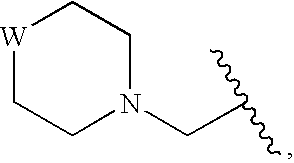Compounds for enzyme inhibition
a technology of enzyme inhibition and compound, which is applied in the direction of angiogenin, drug composition, immunological disorders, etc., can solve the problems of limited systemic exposure following po administration of these inhibitors, and achieve the effects of inhibiting or reducing hiv infection in a subject, reducing the rate of muscle protein degradation, and affecting the level of viral gene expression
- Summary
- Abstract
- Description
- Claims
- Application Information
AI Technical Summary
Benefits of technology
Problems solved by technology
Method used
Image
Examples
example 1
[0157]
Compound (003):
[0158] To a 0° C. solution of N-Boc serine(methyl ether) (001) (2.5 g, 11.4 mmol), L-alanine benzyl ester hydrochloride (002) (3.3 g, 11.4 mmol), HOBT (2.5 g, 18.2 mmol) and HBTU (6.9 g, 18.24 mmol) in tetrahydrofuran (400 mL) was added a solution of N,N-diisopropylethylamine (8.0 mL, 45.6 mmol) in tetrahydrofuran (50 mL) over 10 minutes. The mixture was stirred at room temperature for another 5 hours. Most of the solvents were removed under reduced pressure and the resulting material diluted with ethyl acetate (300 mL). The solution was then washed with saturated aqueous sodium bicarbonate (2×50 mL) and brine (100 mL). The organic layers were dried over sodium sulfate and filtered through Celite-545. The solvents were removed under reduced pressure and the residue was purified by flash chromatography (hexane and ethyl acetate), and the desired compound (003) (4.4 g) was isolated and characterized by LC / MS (LCRS (MH) m / z: 457.23).
Compound (004):
[0159] To a ...
example 2
[0164]
Compound (013):
[0165] To a 0° C. solution of N-Boc L-leucine (011) (2.6 g, 11 mmol), L-phenylalanine benzyl ester hydrochloride (012) (2.9 g, 10 mmol), HOBT (1.7 g, 11 mmol) and HBTU (3.9 g, 11 mmol) in tetrahydrofuran (200 mL) was added a solution of N,N-diisopropylethylamine (4.9 mL, 30 mmol) in tetrahydrofuran (10 mL) over 5 minutes. The mixture was stirred at room temperature for another 5 hours and became homogenous. It was then diluted with ethyl acetate (300 mL) and washed with saturated aqueous sodium bicarbonate (2×50 mL) and brine (100 mL). The organic layers were dried over sodium sulfate and filtered through Celite-545. The solvents were removed under reduced pressure and the residue was purified by flash chromatography (hexane and ethyl acetate) to provide (013) (4.4 g) as characterized by LC / MS (LCRS (MH) m / z: 469.26).
Compound (014):
[0166] To a 0° C. solution of (013) (4.32 g, 9.24 mmol) in tetrahydrofuran (100 mL) was added 10% Pd / C (500 mg). The resulting ...
example 3
[0175]
Compound (025):
[0176] To a 0° C. solution of Fmoc-Val-OH (024) (348 mg, 1.6 mmol) in dichloromethane (4 mL) were added MSNT (474 mg, 1.6 mmol) and N-methyl-imidazole (0.13 mL, 1.6 mmol). HMPB resin (400 mg, 0.32 mmol) was added once the mixture became homogenous. The resulting reaction mixture was allowed to shake for two hours at room temperature. The resin was filtered off, washed with N,N-dimethylformamide (3×10 mL) and dichloromethane (3×10 mL), and was allowed to air dry to yield (025).
Compound (026):
[0177] Resin (025) was placed in a solution of 20% piperidine in N,N-dimethylformamide (20 ml) and the resulting mixture was shaken at room temperature for 1 hour. The resin was filtered off and washed with N,N-dimethylformamide (3×10 mL) and dichloromethane (3×10 mL).
[0178] To a 0° C. solution of Fmoc-Ser(OMe)-OH (546 mg, 1.6 mmol) in N,N-dimethylformamide (4 mL) were added HOBT (245 mg, 1.6 mmol), HBTU (606 mg, 1.6 mmol,) and N,N-diisopropylethylamine (0.6 mL, 3.2 mmo...
PUM
 Login to View More
Login to View More Abstract
Description
Claims
Application Information
 Login to View More
Login to View More - R&D
- Intellectual Property
- Life Sciences
- Materials
- Tech Scout
- Unparalleled Data Quality
- Higher Quality Content
- 60% Fewer Hallucinations
Browse by: Latest US Patents, China's latest patents, Technical Efficacy Thesaurus, Application Domain, Technology Topic, Popular Technical Reports.
© 2025 PatSnap. All rights reserved.Legal|Privacy policy|Modern Slavery Act Transparency Statement|Sitemap|About US| Contact US: help@patsnap.com



